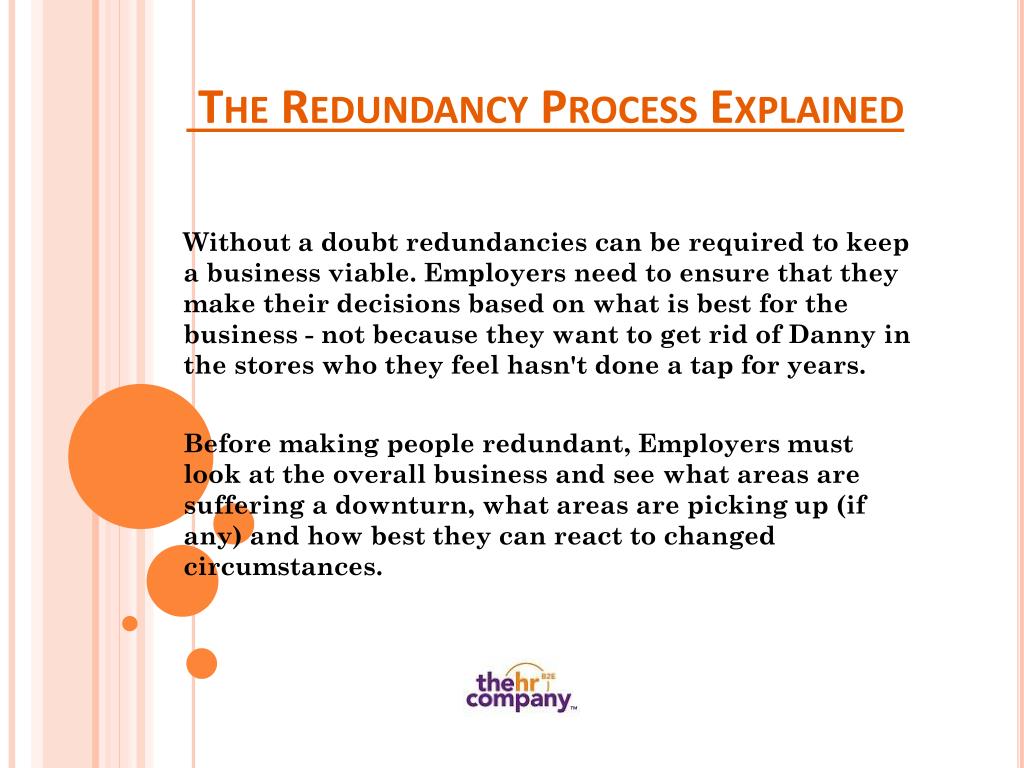If a Company Goes Bust Who Pays Redundancy? Legal Insights for UK Personnel
Wiki Article
Examining the Interaction Between Firm Redundancy and Organizational Adaptability for Future Development
In the dynamic landscape of today's business globe, the intricate connection between business redundancy and business flexibility arises as an important aspect for continual development and success. Firms often face the challenge of striking a delicate balance between preserving a level of redundancy to alleviate threats and promoting flexibility to react promptly to the ever-evolving market needs.Relevance of Firm Redundancy
Firm redundancy is a crucial element that enhances organizational resilience and mitigates operational threats. By including redundancy actions within the business structure, firms can much better stand up to unanticipated interruptions and changes in the company atmosphere. Redundancy functions as a strategic buffer, allowing firms to adjust and react efficiently to unforeseen challenges without compromising important operations.One key aspect of the relevance of firm redundancy is its duty in making certain connection during times of crisis. When faced with abrupt adjustments or emergency situations, repetitive systems, resources, or personnel can tip in to keep vital functions and prevent prevalent interruptions. This continuity not just safeguards the firm's track record and client count on yet likewise minimizes economic losses and functional downtime.
Strategies for Organizational Adaptability

An additional essential method is spending in modern technology and framework that can sustain adaptability and scalability. Implementing digital devices, automation, and data analytics can streamline operations, improve efficiency, and offer important insights for notified decision-making. Furthermore, producing adaptable organizational structures that allow for fast changes to market characteristics and consumer demands is necessary for remaining affordable in a quickly progressing atmosphere. By proactively identifying potential disruptions and possibilities, companies can proactively adjust and flourish in an ever-changing organization landscape.
Harmonizing Redundancy and Versatility
Achieving an unified equilibrium in between operational redundancy and business versatility is critical in browsing the complexities of a vibrant service environment. Redundancy within a firm offers more a safeguard, guaranteeing connection and stability in procedures. However, an unwanted of redundancy can result in inadequacies and impede flexibility to changing market problems. On the other hand, organizational flexibility enables companies to respond immediately to external interruptions and confiscate new chances. Striking the right balance in between redundancy and versatility is a fragile procedure that requires a deep understanding of the company's objectives, industry dynamics, and threat resistance.To attain this equilibrium, business require to carry out routine evaluations of their operations to determine areas where redundancy is required for risk mitigation and where adaptability can drive innovation and development. Applying adaptable frameworks, promoting a culture of continuous learning and renovation, and urging open interaction across all levels of the company are vital methods to balance redundancy and versatility effectively. By aligning these 2 important aspects, companies can place themselves for lasting growth and success in an ever-changing business landscape.
Study on Adaptation Success
In examining circumstances of successful organizational adjustment, it ends up being evident that the interaction between functional redundancy and versatility is a defining variable in forming resilient organizations. One engaging study is that of Netflix. At first a DVD rental solution, Netflix showed amazing adaptability by transitioning right into browse around this web-site a streaming platform when digitalization interfered with the industry. By purposefully purchasing technology and web content development, Netflix not only endured but grew in a rapidly progressing market. Another standout instance is Amazon. Beginning as an on the internet book shop, Amazon continually adjusted its organization model, expanding right into diverse fields such as cloud computing and expert system. This versatility allowed Amazon to remain in advance of competitors and fulfill transforming consumer needs. Finally, Adobe offers a significant illustration of successful adjustment. The firm shifted from offering software program licenses to a subscription-based model, making sure reoccuring revenue streams and improved client involvement. These case studies highlight the relevance of functional redundancy paired with organizational adaptability in promoting long-lasting development and competition.Building Strength for Future Development
Building strength for future growth calls for a calculated alignment of functional processes with market characteristics and emerging fads. Companies have to adapt find out this here to transforming atmospheres by cultivating a culture of adaptability, advancement, and continual enhancement.Moreover, promoting solid relationships with stakeholders, such as consumers, employees, vendors, and the community, is crucial for weathering uncertainties and keeping trust fund and support during stormy times. Effective communication and openness play a vital function in structure resilience, as they assist facilitate and align expectations partnership in browsing uncertainties.
In addition, companies need to prioritize discovering and growth initiatives to upskill employees and furnish them with the essential devices to adapt to changing situations. By spending in their labor force, firms can boost their adaptability and agility, ultimately enhancing their durability for lasting future development.
Verdict

In the dynamic landscape of today's business globe, the detailed connection in between firm redundancy and organizational versatility arises as an essential variable for sustained growth and success. Business usually face the difficulty of striking a fragile balance in between keeping a level of redundancy to reduce dangers and cultivating flexibility to respond swiftly to the ever-evolving market demands.To accomplish this equilibrium, firms require to conduct routine assessments of their operations to identify areas where redundancy is needed for threat reduction and where flexibility can drive innovation and growth.In conclusion, the interplay between business redundancy and organizational versatility is vital for future growth. Building resilience through a combination of redundancy and versatility will guarantee that business are prepared for the difficulties of the future.
Report this wiki page